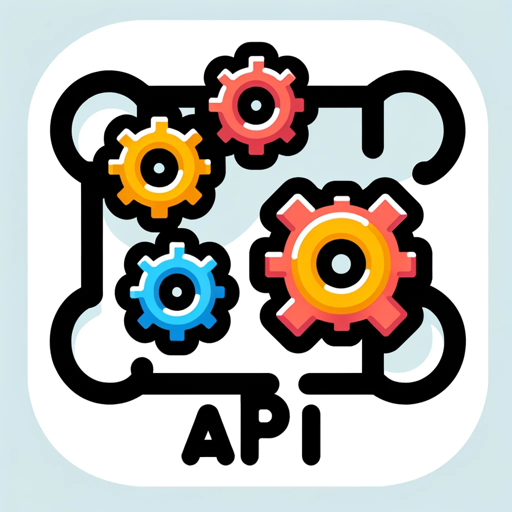AI API documentation-AI-powered API documentation.
AI-Powered API for Seamless Integration.
Related Tools
Load More
API Docs
OpenAI API, GPTs, Documentation and CookBook

API
An API expert, offering technical advice and examples.

Alpha Notes
Converts YouTube videos and web articles into personalized learning guides.

DAIV
Dévoué à l'excellence en JS, Nuxt3, et React
User Guides Documentation Builder
Drop in any requirement, user story, technical task, feature, and i'll articulate a relevant user guide document for you with insights!
API Finder
Assists in finding and detailing APIs. Also guide users on how to effectively utilize APIs in their projects.
20.0 / 5 (200 votes)
Introduction to AI API Documentation
AI API documentation provides comprehensive guides and references for developers to integrate and utilize AI capabilities in their applications. These APIs cover a range of functionalities including text generation, speech-to-text, text-to-speech, image generation, moderation, embeddings, and more. The primary design purpose is to enable developers to leverage advanced AI models for various use cases such as content creation, data analysis, language translation, and interactive applications. For example, a developer can use the text generation API to draft documents automatically or the speech-to-text API to transcribe audio recordings into text format.

Main Functions of AI API Documentation
Text Generation
Example
Drafting a blog post
Scenario
A content creator can use the text generation API to generate draft versions of blog posts. By providing a topic or a few keywords, the API can produce coherent and relevant text that serves as a starting point for the final article.
Speech-to-Text
Example
Transcribing interviews
Scenario
Journalists can utilize the speech-to-text API to transcribe recorded interviews. This saves time and effort, allowing them to focus on analyzing the content and writing their articles instead of manually transcribing audio.
Image Generation
Example
Creating marketing visuals
Scenario
Marketers can use the image generation API to create unique visuals for campaigns. By inputting a text description, such as 'a beach sunset with palm trees,' the API generates an image that can be used in promotional materials.
Ideal Users of AI API Documentation Services
Developers and Programmers
Developers looking to integrate AI functionalities into their applications can greatly benefit from these APIs. They provide powerful tools to add features like natural language processing, image recognition, and automated content generation without needing to build these capabilities from scratch.
Content Creators and Marketers
Content creators and marketers can use these APIs to enhance their content creation process. Whether it's generating written content, transcribing videos and podcasts, or creating engaging visuals, these tools help streamline the workflow and boost productivity.

How to Use AI API Documentation
Visit aichatonline.org for a free trial without login, also no need for ChatGPT Plus.
Start by exploring the free trial offered on aichatonline.org to get familiar with the AI API documentation and services without any login or subscription requirements.
Obtain an API Key
Sign up on the official website to obtain your unique API key. This key will be required for authenticating your API requests.
Read the API Documentation
Thoroughly read the API documentation to understand the available endpoints, request formats, and response structures. This will help you integrate the APIs efficiently.
Make API Requests
Use tools like Postman or curl to start making API requests. Begin with basic requests to understand the flow and then move on to more complex interactions.
Integrate and Optimize
Integrate the API into your applications, and optimize the usage by handling errors, managing rate limits, and utilizing best practices mentioned in the documentation.
Try other advanced and practical GPTs
GeneralWasteoftime
AI-powered insights for military strategies.

[GPT 4.5 Unofficial] Best General Purpose GPT
AI-Powered Solutions for Every Need
![[GPT 4.5 Unofficial] Best General Purpose GPT](https://files.oaiusercontent.com/file-xNZcoZbvw4dhxbQ3861xHyKc?se=2123-12-17T18%3A50%3A30Z&sp=r&sv=2021-08-06&sr=b&rscc=max-age%3D1209600%2C%20immutable&rscd=attachment%3B%20filename%3D183cd01a-2ede-4883-bd1a-044251572105.png&sig=nMRsaReCPiy8Q7OIrceoRrPpEhG2Xc1eU3Fzw6I6K6M%3D)
Plant Selector
AI-powered gardening solutions made simple.

OCR: PDF- and image-reader
AI-powered text extraction made easy

Environmental Justice Tutor
AI-powered insights into environmental justice.

Screenshot Solver
AI-powered tool for screenshot analysis

Pytorch Transformer Model Expert
AI-Powered Pytorch Transformer Assistance

AutoLISP Ace
AI-powered AutoLISP optimization tool

Obi
AI-driven solutions for creativity and problem-solving

One Word Domains
AI-powered domain name generator

Medical AI
AI-Powered Medical Insights

Hugin | Finds your answer by reasoning
AI-powered reasoning for in-depth answers.

- Language Translation
- Image Processing
- Text Generation
- Content Moderation
- Speech Recognition
AI API Documentation: Common Questions and Answers
What is the primary use of the AI API documentation?
The AI API documentation provides guidelines and references for developers to integrate AI capabilities into their applications, including text generation, image processing, speech recognition, and more.
How can I get started with using the AI API?
To get started, visit aichatonline.org for a free trial, obtain an API key, read the documentation to understand the endpoints, and start making API requests using tools like Postman or curl.
What are some common use cases for the AI API?
Common use cases include drafting documents, writing code, answering questions, analyzing text, providing natural language interfaces, tutoring, translating languages, and simulating characters for games.
How do I handle errors and rate limits when using the AI API?
Handle errors by implementing proper error handling in your code, and manage rate limits by optimizing your requests, using retries with exponential backoff, and referring to the rate limit guidelines in the documentation.
Can I use the AI API for real-time applications?
Yes, the AI API supports real-time applications such as speech-to-text and text-to-speech, but it is important to handle latency and ensure that the API response times meet your application's requirements.